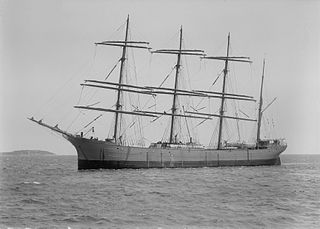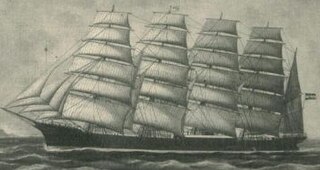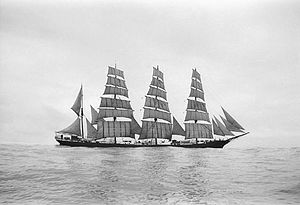
A barque, barc, or bark is a type of sailing vessel with three or more masts having the fore- and mainmasts rigged square and only the mizzen rigged fore and aft. Sometimes, the mizzen is only partly fore-and-aft rigged, bearing a square-rigged sail above.

The Flying P-Liners were the sailing ships of the German shipping company F. Laeisz of Hamburg.

Lawhill was a steel-hulled four-masted barque rigged in "jubilee" or "baldheaded" fashion, i.e. without royal sails over the top-gallant sails, active in the early part of the 20th century. Although her career was not especially remarkable, save perhaps for being consistently profitable as a cargo carrier, in the 1930s Richard Cookson went on board and extensively documented Lawhill's internals and construction, which was later published in the Anatomy of the Ship series.

Iron-hulled sailing ships represented the final evolution of sailing ships at the end of the age of sail. They were built to carry bulk cargo for long distances in the nineteenth and early twentieth centuries. They were the largest of merchant sailing ships, with three to five masts and square sails, as well as other sail plans. They carried lumber, guano, grain or ore between continents. Later examples had steel hulls. They are sometimes referred to as "windjammers" or "tall ships". Several survive, variously operating as school ships, museum ships, restaurant ships, and cruise ships.

Passat is a German four-masted steel barque and one of the Flying P-Liners, the famous sailing ships of the German shipping company F. Laeisz. She is one of the last surviving windjammers.

Peking is a steel-hulled four-masted barque. A so-called Flying P-Liner of the German company F. Laeisz, it was one of the last generation of cargo-carrying iron-hulled sailing ships used in the nitrate trade and wheat trade around Cape Horn.

Pommern, formerly Mneme (1903–1908), is an iron-hulled sailing ship. It is a four-masted barque that was built in 1903 at the J. Reid & Co shipyard in Glasgow, Scotland.

Alan John Villiers, DSC was a writer, adventurer, photographer and mariner.

Moshulu is a four-masted steel barque, built as Kurt by William Hamilton and Company at Port Glasgow in Scotland in 1904. The largest remaining original windjammer, she is currently a floating restaurant docked in Penn's Landing, Philadelphia, adjacent to the museum ships USS Olympia and USS Becuna.

The clipper route was the traditional route derived from the Brouwer Route and sailed by clipper ships between Europe and the Far East, Australia and New Zealand. The route ran from west to east through the Southern Ocean, to make use of the strong westerly winds of the Roaring Forties. Many ships and sailors were lost in the heavy conditions along the route, particularly at Cape Horn, which the clippers had to round on their return to Europe.

Preussen (PROY-sin) was a German steel-hulled, five-masted, ship-rigged sailing ship built in 1902 for the F. Laeisz shipping company and named after the German state and kingdom of Prussia. It was the world's only ship of this class with five masts, carrying six square sails on each mast.

Potosi was a five-masted steel barque built in 1895 by Joh. C. Tecklenborg ship yard in Geestemünde, Germany, for the sailing ship company F. Laeisz as a trading vessel. Its primary purpose was as a "nitrate clipper" collecting guano in South America for use in chemical companies in Germany. As its shipping route was between Germany and Chile, it was designed to be capable of withstanding the rough weather encountered around Cape Horn.

Gustaf Adolf Mauritz Erikson was a ship-owner from Mariehamn, in the Åland islands. He was famous for the fleet of windjammers he operated to the end of his life, mainly on the grain trade from Australia to Europe.

Herzogin Cecilie was a German-built four-mast barque (windjammer), named after German Crown Princess Duchess Cecilie of Mecklenburg-Schwerin (1886–1954), spouse of Crown Prince Wilhelm of Prussia (1882–1951). She sailed under German, French and Finnish flags.

The Tall Ships Races are races for sail training "tall ships". The races are designed to encourage international friendship and training for young people in the art of sailing. The races are held annually in European waters and consists of two racing legs of several hundred nautical miles, and a "cruise in company" between the legs. Over one half of the crew of each ship participating in the races must consist of young people.

Pisagua was a four-masted barque that was built for F. Laeisz, Hamburg, Germany in 1892 and served for twenty years, surviving a collision with Oceana in 1912. She was repaired and sold to a Norwegian owner, only to be stranded in the South Shetland Islands the following year.

Placilla was a four-masted barque which was built for F. Laeisz, Hamburg, Germany in 1892. She was sold in 1901 and renamed Optima in 1903. In 1905 she was wrecked on the Haisborough Sands.

Ponape was a four-masted steel–hulled barque which was built in 1903 in Italy as Regina Elena for an Italian owner. In 1911 she was sold to Germany and renamed Ponape. In 1914 she was arrested by HMS Majestic and confiscated as a war prize by the Admiralty. She was renamed Bellhouse In 1915 she was sold to Norwegian owners. In 1925, she was sold to Finland and again named Ponape serving until she was scrapped in 1936.

Priwall was a four-masted steel-hulled barque with royal sails over double top and topgallant sails. The windjammer was ordered by the F. Laeisz shipping company of Hamburg and launched at the Blohm & Voss yard, Hamburg, on 23 June 1917. After delays arising from a shortage of materials during and after First World War, she was completed on 6 March 1920. Priwall was used on the nitrate trade route to the west coast of South America; she also made several voyages from South Australia’s Spencer Gulf grain ports to Europe. Her code Letters were RWLN; in 1934 they were changed to DIRQ.

Admiral Karpfanger was a German four-masted barque that was a cargo ship and sail training ship. She was built near Bremerhaven in 1908 as l'Avenir, which was the name that she bore until 1937. She spent most of her career with the Association Maritime Belge, SA.



















